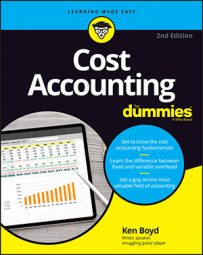To plan your sales and profits in cost accounting, it’s ideal for you to know the breakeven point for every product type you sell. So if you have a store that sells just two product types, compute the breakeven points for both of them.
Say you manage a lumberyard that sells two types of wood to furniture makers: Pristine wood and Sturdy wood. A unit is one board of wood. (If you’re selling first-class hardwoods, the sample prices are pretty close to reality. There’s some serious money in a board 13/16 of an inch thick, 10 inches wide, and 40 inches long.)
Pristine wood is used to make beautiful tabletops and sells for $50 per unit. Variable costs are $30 per unit, and fixed costs total $30,000. The breakeven formula is
Profit ($0) = sales – variable costs – fixed costs
Profit ($0) = (units x $50) – (units x $30) – $30,000
Profit ($0) = units x ($50 – $30) – $30,000
Profit ($0) = units x $20 – $30,000
To finish the calculation, add $30,000 to both sides of the equation. Then divide both sides by $20:
$30,000 = units x $20
$30,000 / $20 = units
1,500 = units
You sell 1,500 units of Pristine wood to break even.
Sturdy wood is used to make pretty good tabletops and sells for $25 per unit. Variable costs are $18 per unit, and fixed costs total $25,000. Here’s the breakeven formula:
Profit ($0) = sales – variable costs – fixed costs
Profit ($0) = (units x $25) – (units x $18) – $25,000
Profit ($0) = units x ($25 – $18) – $25,000
Profit ($0) = units x $7 – $25,000
To finish the calculation, add $25,000 to both sides of the equation. Then divide both sides by $7:
$25,000 = units x $7
$25,000 / $7 = units
3,572 = units
You sell 3,572 units of Sturdy wood to break even.
Pristine wood’s breakeven point in units is less than half of the Sturdy wood’s (1,500 units versus 3,571 units).
A contribution margin of $20 (Pristine wood) beats a contribution margin of $7 (Sturdy wood) any day of the week. The difference in fixed costs is $5,000 — not a big difference. Pristine has a much larger contribution margin to cover fixed costs. That’s why Pristine wood’s breakeven point is so much lower.

